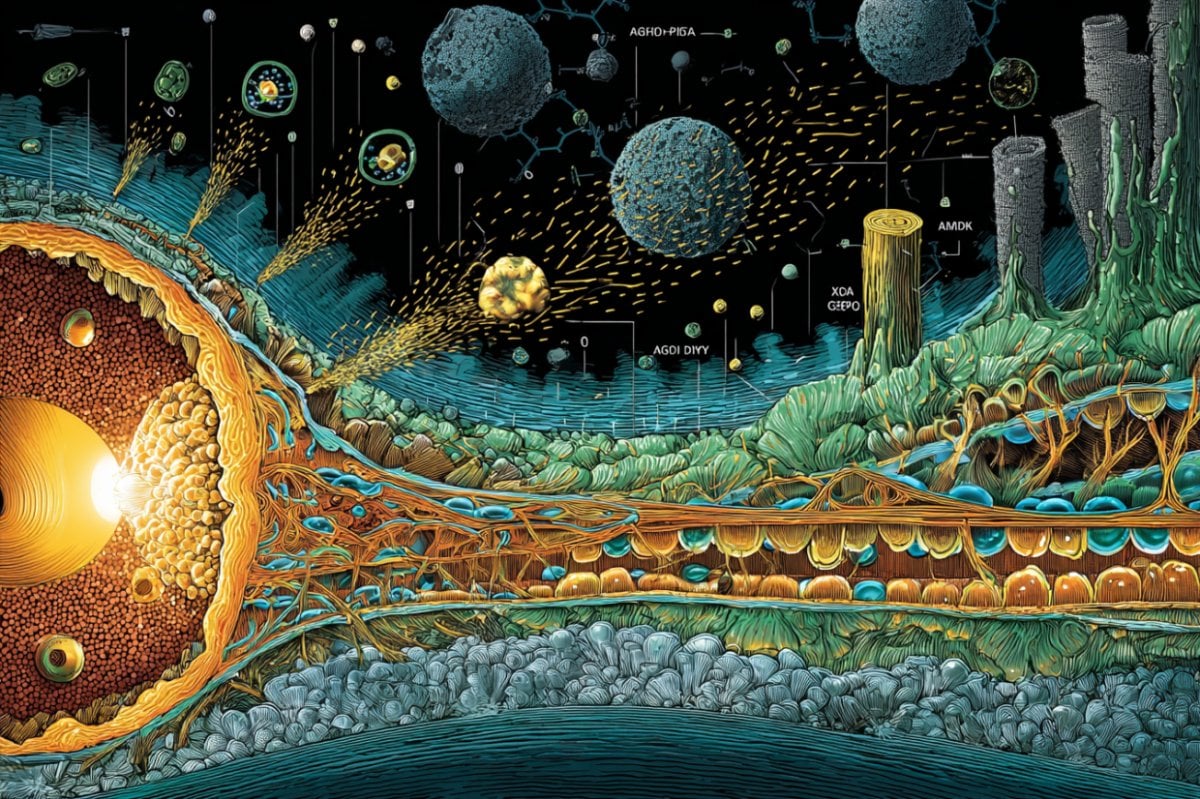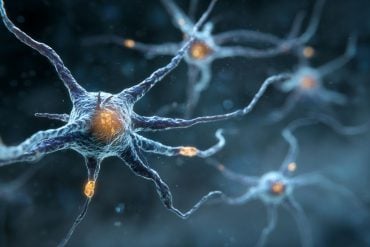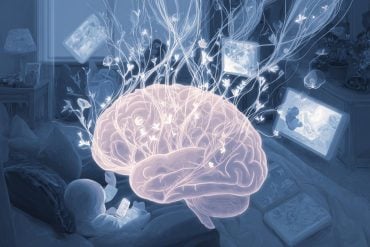Summary: Researchers demonstrated that systemic factors from young mice can rejuvenate the aging retina by alleviating cellular senescence and restoring function. Using heterochronic parabiosis and single-cell RNA sequencing, the study identified AdipoR1 and its downstream AMPK signaling as key drivers of retinal rejuvenation.
Pharmacological activation of AdipoR1 with AdipoRon replicated these benefits, improving mitochondrial health, reducing inflammation, and reversing senescence markers in aged mice. These findings highlight AdipoR1 as a promising therapeutic target for age-related retinal degeneration.
Key Facts:
- Youthful Blood Effects: Exposure to young systemic factors rejuvenates aged mouse retinas, improving function and reducing senescence.
- AdipoR1 Role: AdipoR1 and AMPK signaling are central to reversing retinal aging and restoring mitochondrial health.
- Therapeutic Potential: AdipoR1 agonist AdipoRon successfully mimics rejuvenation effects and may be a future treatment for vision loss.
Source: Neuroscience News
As the human population ages, one of the most devastating and prevalent consequences is the gradual loss of vision due to age-related retinal degeneration.
The retina — a delicate, multilayered neural tissue — is responsible for capturing light and transmitting visual information to the brain, making it essential for sight and quality of life. Yet aging inevitably compromises retinal structure and function, driving conditions like macular degeneration, diabetic retinopathy, and glaucoma.
These diseases rank among the leading causes of blindness worldwide, creating a pressing need to uncover the mechanisms behind retinal aging and develop effective therapies.
In a breakthrough study, researchers have discovered that youthful blood circulation can rejuvenate aging retinas in mice, alleviating cellular senescence, reducing inflammation, and restoring mitochondrial health.
This work identifies a specific molecular pathway — centered on the receptor AdipoR1 and its downstream AMPK signaling — that underpins these rejuvenating effects. Not only does this deepen our understanding of how systemic factors influence the retina, but it also points to a promising therapeutic strategy for preserving vision as we age.
Aging Retina: A Cellular Landscape in Decline
The retina is a complex tissue composed of neurons, glial cells, and retinal pigment epithelium (RPE), working in concert to support vision. With age, these cell types accumulate damage, oxidative stress, and inflammation, undermining their function and leaving the retina vulnerable to disease.
Using state-of-the-art single-cell RNA sequencing, the team mapped the transcriptomic changes in retinas from young and aged mice.
The analysis revealed widespread alterations: RPE cells, microglia, and retinal ganglion cells were particularly affected, exhibiting increased oxidative stress, inflammatory gene expression, and markers of cellular senescence such as p16.
This senescence — an irreversible arrest of the cell cycle accompanied by a harmful secretory phenotype — has been implicated in age-related decline throughout the body. In the retina, it disrupts homeostasis, accelerates degeneration, and compromises vision.
The Promise of Youthful Blood
To test whether systemic factors could influence retinal aging, the researchers employed heterochronic parabiosis (HP) — surgically joining the circulatory systems of a young and an old mouse.
After two months of shared blood circulation, aged mice showed remarkable improvements: enhanced retinal electrophysiological responses, reduced senescent cell burden, decreased neuroinflammation, and improved structural integrity of retinal layers.
Conversely, young mice exposed to aged blood displayed accelerated aging features in their retinas, demonstrating that the systemic environment powerfully modulates retinal health in both directions.
Molecular analysis pinpointed significant rejuvenation of mitochondrial function in aged retinas exposed to young blood. Mitochondria — the cellular powerhouses — are especially vulnerable to age-related damage, leading to impaired energy production and heightened oxidative stress. Restoring mitochondrial function emerged as a key feature of rejuvenation.
The Central Role of AdipoR1
To uncover the molecular drivers of these changes, the team integrated single-cell transcriptomic data with known aging gene sets. One receptor stood out: adiponectin receptor 1 (AdipoR1).
Already known for its roles in metabolic regulation and photoreceptor health, AdipoR1 was found to mediate much of the rejuvenating effect of young blood on the retina.
In aged retinas, AdipoR1 expression was diminished, contributing to mitochondrial dysfunction and cellular senescence. Young circulation — or pharmacological activation of AdipoR1 — restored its expression and activated the AMPK signaling pathway, which is crucial for cellular energy balance and mitochondrial quality control.
A Therapeutic Avenue: AdipoRon
Having identified AdipoR1 as a rejuvenation target, the team tested whether activating it directly could replicate the benefits of youthful blood. They treated aged mice with AdipoRon, an orally available AdipoR1 agonist, for two months.
The results were striking: treated mice showed improved retinal function, reduced senescent markers, diminished inflammatory cytokines, and enhanced mitochondrial health.
At the cellular level, AdipoRon boosted mitochondrial membrane potential, promoted the clearance of damaged mitochondria through mitophagy, and restored ATP production — hallmarks of a healthy, youthful retinal environment.
These findings indicate that targeting AdipoR1 pharmacologically could be a viable therapy for preventing or even reversing age-related retinal degeneration.
Implications and Future Directions
This study provides compelling evidence that the aging retina is not beyond repair and that systemic factors can profoundly influence its health. AdipoR1 emerges as a critical mediator of this rejuvenation, offering a tangible therapeutic target.
As the population ages and the prevalence of blinding retinal diseases rises, interventions that restore youthful function to the retina could have enormous societal impact.
Beyond vision, the findings also underscore a broader principle: the systemic milieu profoundly affects tissue aging throughout the body. Understanding and harnessing these factors could revolutionize how we approach age-related diseases in multiple organs.
The next steps will include translating these findings into human models, testing the safety and efficacy of AdipoR1 agonists in clinical trials, and further dissecting how other systemic factors contribute to retinal aging and rejuvenation.
A Vision for the Future
Our sense of sight is often taken for granted until it begins to fade. This research shines a hopeful light on the possibility of preserving and restoring vision by tapping into the body’s own molecular pathways.
By revealing the rejuvenating potential of youthful systemic factors and identifying AdipoR1 as a key regulator, the study opens the door to therapies that could help millions retain the gift of sight well into old age.
Funding: This work was supported by the following: National Natural Science Foundation of China (824B2040 to Y.L.); National Key Research and Development Project of China (2020YFA0112701 to Y.Z.); Science and Technology Program of Guangzhou, China (202206080005 to Y.Z.); and China National Postdoctoral Program for Innovative Talents (BX20240440 to X.L.).
About this visual neuroscience research news
Author: Neuroscience News Communications
Source: Neuroscience News
Contact: Neuroscience News Communications – Neuroscience News
Image: The image is credited to Neuroscience News
Original Research: Open access.
“Heterochronic parabiosis uncovers AdipoR1 as a critical player in retinal rejuvenation” by Yidan Liu et al. Science Advances
Abstract
Heterochronic parabiosis uncovers AdipoR1 as a critical player in retinal rejuvenation
Aging induces substantial structural and functional decline in the retina, yet the molecular drivers of this process remain elusive.
In this study, we used heterochronic parabiosis (HP) combined with single-cell RNA sequencing to generate comprehensive transcriptomic profiles of murine retinas from young, aged, and HP pairs, aiming to identify antiaging targets.
Our analysis revealed extensive transcriptional alterations across retinal cell types with aging. HP experiments demonstrated that systemic factors from young mice rejuvenated aged retinas and alleviated senescent phenotypes, while aged blood accelerated aging in young mice.
Integrative analysis pinpointed adiponectin receptor 1 (AdipoR1) and the downstream adenosine 5′-monophosphate–activated protein kinase (AMPK) signaling pathway as central to the molecular mechanisms underlying retinal rejuvenation.
Treatment with the AdipoR1 agonist AdipoRon reversed retinal aging. Mechanistically, AdipoR1-AMPK activation promoted mitochondrial function, contributing to the restoration of youthful cellular phenotypes.
Together, our study identifies AdipoR1 as a therapeutic target for retinal aging and provides insights into the molecular programs driving retinal rejuvenation.







